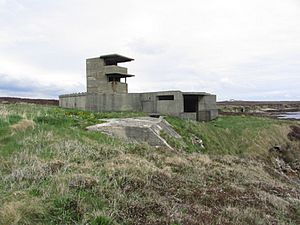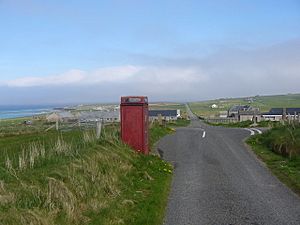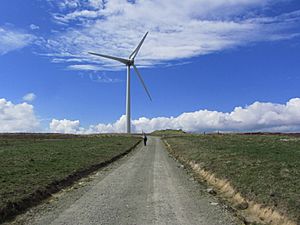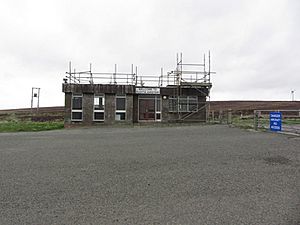Flotta facts for kids
| Norse name | Flottey or Flott-øy |
|---|---|
| Meaning of name | "flat island" (Norse) |
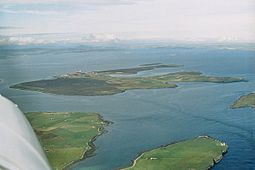 An aerial view of Flotta from the south-west. The oil terminal is visible to the centre-left, with the airport further to the left. South Walls is at the bottom and bottom left, and Switha at the extreme right. |
|
| OS grid reference | ND352938 |
| Coordinates | 58°50′N 3°06′W / 58.83°N 3.1°W |
| Physical geography | |
| Island group | Orkney |
| Area | 876 hectares (3.4 sq mi) |
| Area rank | 57 |
| Highest elevation | West Hill 58 metres (190 ft) |
| Administration | |
| Sovereign state | United Kingdom |
| Country | Scotland |
| Council area | Orkney Islands |
| Demographics | |
| Population | 80 |
| Population density | 9.1 people/km2 |
| Largest settlement | Whome |
Flotta is a small island located in Orkney, Scotland. It sits in a famous body of water called Scapa Flow. Flotta is well-known for its large oil terminal. Ferries connect the island to other places like Houton on the Orkney Mainland, Lyness on Hoy, and Longhope on South Walls. About 80 people live on Flotta.
Contents
History of Flotta Island
At the start of the 1900s, Flotta was a peaceful farming community. Like many small Orkney islands, life was quiet. However, its safe location led to big changes throughout the century. In 1910, 431 people lived on the island. This included blacksmiths, carpenters, and dressmakers.
Flotta During the World Wars
Everything changed when the Royal Navy arrived in Scapa Flow. This happened at the start of the First World War in 1914. Flotta became an important naval base. There's even a photo showing a boxing match on Flotta. About 10,000 people watched it during wartime.
During the First World War, a huge warship called HMS Vanguard sank nearby in 1917. This was one of the worst sea disasters in UK waters. Flotta was again used as a military base during the Second World War.
After the First World War in 1918, many Navy people left. They returned in 1939 for the Second World War. After 1945, Flotta had good piers and facilities. But its population slowly got smaller. It wasn't until 1970 that fresh water was piped to the island from Hoy.
North Sea Oil and Flotta
In 1974, a company called Occidental Petroleum began building the island's oil terminal. This terminal became the second largest in the UK for North Sea oil. The biggest is Sullom Voe in Shetland.
It took only two years to build the terminal. Thousands of workers lived in a "camp" on Flotta. They worked hard to finish the facility quickly. Britain needed more and more oil. The Flotta oil terminal officially opened on January 11, 1977. Tony Benn, the energy minister, opened it.
The oil terminal receives oil from pipelines. These pipelines come from oil fields like Piper and Claymore. It also safely handles oil from the UK Atlantic margins.
Geography and Environment of Flotta
Flotta is located at the southern end of Scapa Flow. The Calf of Flotta is at the island's north-east corner. The island of Fara is about 300 meters (984 feet) away. It lies across Weddel Sound to the north-west.
Other nearby islands include Switha, South Walls, and Hoy. Each is about 1 kilometer (0.6 miles) from Flotta. They are to the south, south-west, and west. Nevi Skerry is about 1 kilometer (0.6 miles) east of Flotta. It is in the Sound of Hoxa. South Ronaldsay is about 2.5 kilometers (1.6 miles) east of Flotta. It is also across the Sound of Hoxa.
The highest point on Flotta is West Hill. It is 58 meters (190 feet) high. A wind turbine stands next to it. The main village is Whome. It is in the middle of the southern part of the island. To the north, Whome is separated from the Golta Peninsula by Pan Hope. This is a bay affected by tides.
Flotta's Flora and Fauna
Flotta has a seal colony at Stanger Head. This is at the south-east corner of the island. The Royal Navy planted 1,000 spruce trees during the Second World War. These trees are near the Naval Cinema, between Sutherland Pier and the oil terminal. About 10% of these spruce trees are still alive. The oil company has also planted 40,000 trees and shrubs. Much of the western side of the island is covered in heath plants. The Golta Peninsula in the north-east also has heath.
Community Life on Flotta
Flotta has a population of 80 people. They live in 48 households. The main village is Whome. The community primary school is currently closed. This is because there are no children of primary school age left on the island.
Healthcare services come from the Stromness Surgery. A nurse practitioner lives and works on Flotta. Flotta Fire Station closed on October 25, 2012. Its services moved to the Scottish Fire and Rescue Service on April 1, 2013.
A 2.3-megawatt wind turbine was installed in 2010. It will give the community £100,000 over its lifetime. This money helps the island.
People from Flotta
- Prof Sutherland Simpson FRSE (1863-1926) was a physiologist.
Flotta's Economy
The main industry on Flotta is energy. This includes making and moving energy. Repsol Sinopec Energy UK Limited's Flotta Oil Terminal processes oil. This oil comes from the North Sea. The terminal has been working for 36 years. Opus Plus Ltd., an environmental research company, also works at the oil terminal.
The 2.3-megawatt (MW) Flotta wind turbine started working in June 2010. It cost £3 million. The turbine is connected to the National Grid. Its hub is 64 meters (210 feet) high. The blades have a diameter of 71 meters (233 feet).
The Orkney Island Council also provides jobs for several people on Flotta. Farming is still important for the island's money. Handicrafts also bring in income. A few residents also work on the Orkney Mainland.
The island has one shop. It works as a general store, a post office, and a petrol station. The closest supermarkets are in Kirkwall. These include Tesco and Lidl.
Flotta has a main water supply. Boreholes are also used for water. Flotta did not have main electricity until 1977. Before that, most homes had their own generators. Scottish Hydro Electric supplies the main electricity now. The island is connected to the BT telephone network. Mobile phone service can sometimes be a problem. Broadband internet is available on the island. There is no main gas supply on Flotta. However, coal and heating oil are delivered regularly. Calor Gas is stored at the shop.
In 2005, people thought Flotta could grow its economy. They considered heritage tourism. This would focus on the Second World War buildings around the island. Building a marina was also considered at that time.
Transport on Flotta
Marine Transport
Orkney Ferries serves the island. Ferries link Flotta to Houton on the Orkney Mainland. They also go to Lyness and Longhope on Hoy. The ferries dock at Gibraltar Pier. This pier is also called Heyspan Pier. It is in Weddel Sound, to the north-west of the island.
Orkney Ferries' South Isles service usually uses the MV Hoy Head. The MV Thorsvoe is used as a backup boat. Flotta is a few miles from St Margaret's Hope on South Ronaldsay. St Margaret's Hope has a direct ferry to mainland Scotland. However, there is no direct public ferry between Flotta and South Ronaldsay. To get to the Scottish mainland, you must take a ferry to Houton. Then you travel by road to Stromness or St. Margaret's Hope. This route is much longer.
Sutherland Pier is a few hundred meters south-west of Gibraltar Pier. It is also in Weddel Sound. Local boats similar in size to the ferries use Sutherland Pier. A third public pier is Pan Pier. It is on the southern side of Pan Hope, the island's central bay. Smaller private boats use Pan Pier. The oil terminal has its own jetty. It is on the northern side of the island. This jetty can hold large oil tankers.
Flotta Airport
Flotta Airport is on the western side of the island. Its airport code is FLH. The asphalt runway is 16/34. It is 70 feet (21 meters) high. The runway is 2,490 feet (759 meters) long. The airport also has a helipad. It is next to the eastern side of the northern end of the runway.
The first plane landed on Flotta on May 28, 1976. It was a Loganair Islander aircraft. The first regular air service to Flotta started on March 1, 1977. It flew via Hoy. Another Loganair Islander aircraft flew this service. British Airways also used a Hawker Siddeley HS748. This was for crew changes at the Occidental Petroleum oil terminal. Loganair stopped its regular flights to Flotta in 1981. This was because the oil company started offering free ferry services.
On April 20, 1983, a charter flight crashed at Flotta Airport. It was an Air Ecosse de Havilland DHC-6 from Aberdeen Airport. The plane was caught in a strong crosswind when it landed. There were no serious injuries or deaths among the two crew and ten passengers.
In 2001, Elf Exploration UK plc took over the airstrip. Today, the airfield is mainly used by emergency services.
Road Transport
The main roads on Flotta are the B9045 and the B9046. These roads connect the ferry terminal to the village of Whome. Flotta does not have causeways like the Churchill Barriers. These causeways allow vehicles to drive to nearby islands. All road vehicles must use the ferry to get to the Orkney Mainland and to Hoy.
See also
 In Spanish: Flotta para niños
In Spanish: Flotta para niños


